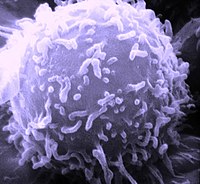
Photo from wikipedia
The precise interaction between the immune system and severe acute respiratory syndrome coronavirus 2 (SARS‑CoV‑2) is critical in deciphering the pathogenesis of coronavirus disease 2019 (COVID‐19) and is also vital… Click to show full abstract
The precise interaction between the immune system and severe acute respiratory syndrome coronavirus 2 (SARS‑CoV‑2) is critical in deciphering the pathogenesis of coronavirus disease 2019 (COVID‐19) and is also vital for developing novel therapeutic tools, including monoclonal antibodies, antivirals drugs, and vaccines. Viral infections need innate and adaptive immune reactions since the various immune components, such as neutrophils, macrophages, CD4+ T, CD8+ T, and B lymphocytes, play different roles in various infections. Consequently, the characterization of innate and adaptive immune reactions toward SARS‐CoV‐2 is crucial for defining the pathogenicity of COVID‐19. In this study, we explain what is currently understood concerning the conventional immune reactions to SARS‐CoV‐2 infection to shed light on the protective and pathogenic role of immune response in this case. Also, in particular, we investigate the in‐depth roles of other immune mediators, including neutrophil elastase, serum amyloid A, and syndecan, in the immunopathogenesis of COVID‐19.
Journal Title: Journal of Medical Virology
Year Published: 2022
Link to full text (if available)
Share on Social Media: Sign Up to like & get
recommendations!